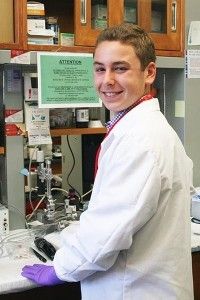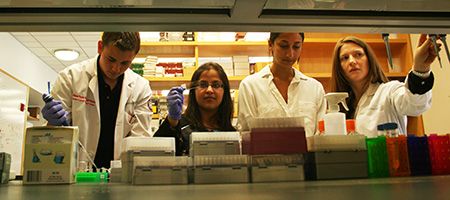The height of dedication
Matthew Bernstein was 14 when he lost his 11-year-old brother Zachary to a rare, deadly form of brain cancer.
Now the 16-year-old is contributing to a cure, by spending his summer in the lab of Weill Cornell Medicine neurosurgeon Mark Souweidane, a world expert in diffuse intrinsic pontine glioma (DIPG) who is pioneering new approaches to its treatment. Souweidane recently treated the final patient in a groundbreaking clinical trial testing convection-enhanced delivery as a way to bypass the blood-brain barrier to inject cancer-fighting drugs directly to the site of DIPG tumors.
Working closely with instructor Uday Maachani, the Lynbrook High School junior helped kick-start the lab’s efforts to build a database of thalamic glioma samples – data that will be invaluable in the lab’s new research efforts.
He also got to spend some time in the operating room observing surgeries, which he said was the highlight of the experience.
Matthew has been involved in the field of pediatric brain cancer since Zachary’s death in March of 2014. In addition to his scientific endeavors, he is also the Youth Volunteer Coordinator for the Fly a Kite Foundation, which his parents launched to support other families facing DIPG.
Always interested in math and science, Matthew is now eyeing a career in medicine.
“When [Zachary] was sick, I saw a lot of oncologists, physical therapists, anesthesiologists and what they do,” he told the Long Island Herald. “Because of my experiences, I was exposed to the neurological field and surgery, so I’m leaning toward that now.”
Matthew is one of several aspiring young scientists and doctors to get some hands-on experience in the pediatric research labs at the Weill Cornell Brain and Spine Center.
Benjamin Shtaynberger joined neurosurgeon Jeffrey Greenfield’s team to assist in assembling and evaluating the data that will form the basis for a new academic paper on gliomatosis cerebri (GC).
Weill Cornell medical students Emilie George and Raymond Chang tested new drugs and drug combinations against GC and DIPG. Umberto Tosi used PET imaging to evaluate the cancer drug dasatinib, modified to fluoresce, in mice models with DIPG, and fellow student Christopher Marnell tested two-dimensional peptide-based nanofibers (NFP) as drug carriers to slow clearance rates and improve the distribution of chemotherapeutics injected into a DIPG tumor.
Tina Bharani, a medical student from Qatar Weill Cornell Medical School, spent the summer on a brand-new line of investigation for Dr. Greenfield, looking at immunoglobulin superfamily member 3 (IgSF3) and its role in glioma invasiveness. IgSF3 is a novel gene candidate identified by the Greenfield lab thought to play a role in how tumors spread throughout healthy tissue in the brain. The lab has launched a number of new projects to investigate the function of this gene in invasive brain cancers like gliomatosis cerebri.
Jared Bassett, a high school student who was new to lab work, assisted Tina and research assistant Rachel Yanowitch on the new IgSF3 project.




